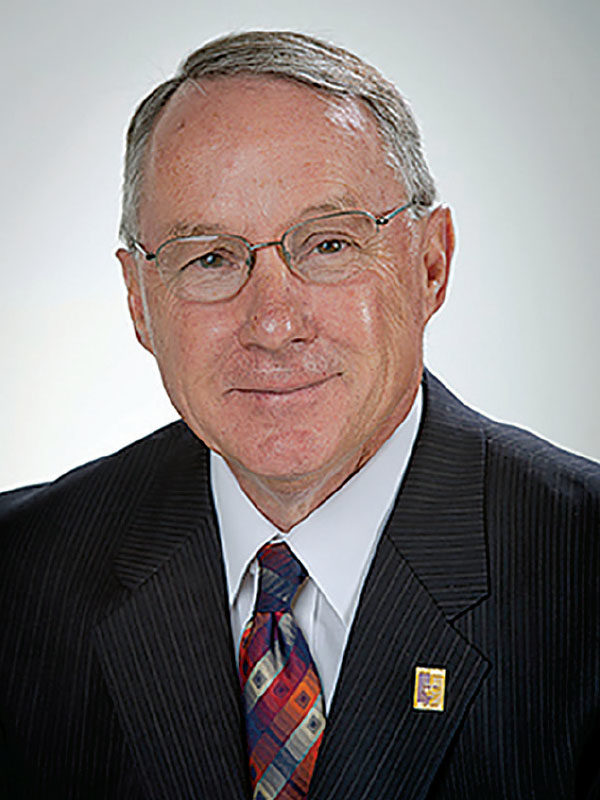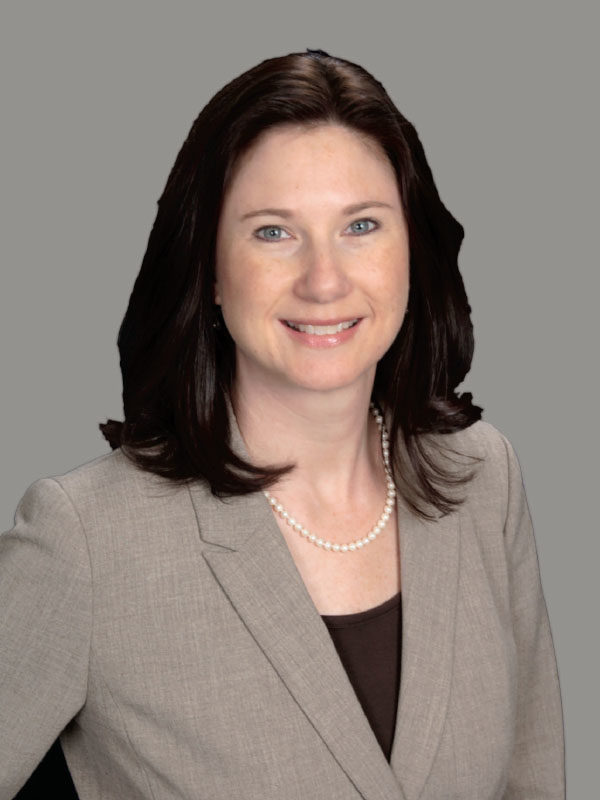Each year, NACUBO honors individuals and institutional excellence through its awards program. The 2015 recipients were recognized in July during the annual meeting in Nashville at a ceremony supported by Sodexo.
Patterson Receives Distinguished Business Officer Award

John D. Patterson, vice president for administration and campus life, Pittsburg State University (Pitt State), Pittsburg, Kan., received NACUBO’s most prestigious honor for outstanding contributions to business and financial management in higher education.
During his 25-year tenureat Pitt State, Patterson hasplayed an integral part inmany of the changes at the university. Under his leadership, enrollment has risen 27 percent; staff has increased 37 percent; and construction projects have resulted in new centers for technology, the arts, research, student recreation, indoor events, and student health, as well as the renovation of numerous buildings.
Patterson’s professionalism created an environment of trust and security, which in turn helped facilitate the generosity of donors over many years. His actions and opinions are highly regarded by the executive board, finance and investment committees, and the trustees.
Most notably, when Patterson served as treasurer of the university’s foundation, from 1990–2013, the foundation’s total assets grew from $9 million to $84 million.
In the past 42 years, Patterson has worked at four of the larger universities in Kansas. He began his career in the budget office at Wichita State University. He then became controller at Washburn University, Topeka, and served as comptroller at the University of Kansas, Lawrence.
In addition to his workon campus, Patterson hasserved as secretary for NACUBO’s board of directors and president of CACUBO. He has also participated on numerous committees in both organizations.
Kochard Selected for Adams Award

Lawrence Kochard, chief executive officer/chief investment officer, University of Virginia Investment Management Company (UVIMCO), Charlottesville, earned this year’s NACUBO Rodney H. Adams Endowment Management Award.
Kochard joined UVIMCO in 2011, and under his leadership the company’s long-term pool has grown from $4.9 billion to $6.4 billion, and has distributed more than $620 million to the university and its related foundations. Additionally, as of June 2013, UVIMCO’s long-term pool’s three-year performance ranked as the top-performing endowment fund among those of the 31 colleges and universities with more than $2 billion in assets under management, as reported by Cambridge Associates.
Prior to joining UVIMCO, Kochard served as chief investment officer at Georgetown University, Washington, D.C.,and managing director of equity and hedge fund investments for the Virginia Retirement System, where he oversaw public and private equities totaling approximately $27 billion in assets.
Beyond his work in the endowment and investment community, he coauthored Foundation and Endowment Investing, which profiles the best practices of 12 accomplished investment officers.
Kochard serves on the boards or investment committees of several organizations, including Janus Capital Group, Virginia Retirement System, and the Richard A. Mayo Center for Asset Management at the University of Virginia’s Darden School of Business.
His experience over three decades has given him a broad perspective of capital markets and a commanding view of successful investment management. He has trained and mentored future investment managers, and helped organizations develop their investment philosophies and practices.
Daher, Levenson Receive 2015 Tax Award
Dominic L. Daher, director of internal audit and tax compliance, University of San Francisco, and Joel F. Levenson, associate director, tax compliance, University of Central Florida, Orlando, received the NACUBO 2015 Tax Award.

In his role at the University of San Francisco, Daher is responsible for overseeing an annual internal audit plan, ensuring compliance with institutional policies and government regulations, managing the institution’s enterprise risk assessment, administering the whistleblower hotline, and serving as a resource to the university in all tax matters.
He also is an adjunct professor of law at the university, where he teaches classes in accounting for lawyers and law practice management.
As an active member of the NACUBO Tax Council, Daher has spoken at the Tax Forum and the Unrelated Business Income Tax program.
He has twice hosted the Tax Council’s annual meeting at the University of San Francisco, helping to arrange meeting logistics and extracurricular activities for council members.
Daher is also a writer, editor, and commentator on tax issues that affect colleges and universities. He sits on several advisory and editorial boards, including M&A Tax Report, Taxation of Exempts, The Exempt Organization Tax Review, and Corporate Business Taxation Monthly.

At the University of Central Florida, Levenson manages tax compliance in the areas of unrelated business income tax, worker classification, tax exempt debt, information reporting, and multistate sales taxes. He also advises senior management on tax-related risks and potential changes to tax compliance.
As a member of the NACUBO Tax Council, he has volunteered to help staff advocate or discuss tax matters with federal policy experts and lawmakers, as well as campus audiences.
Since his time on the council, he has traveled to Washington to explain tax reporting issues to Senate Finance Committee staff and participated in a webcast for Washington-based campus lobbyists, which highlighted tax reform proposals affecting colleges and universities.
Over the past two years, Levenson has worked with a joint subcommittee of NACUBO’s student financial services and tax councils to develop guidance for members on all aspects of Form 1098-T reporting. He has also devoted a significant amount of time to help NACUBO members respond to IRS penalties related to Form 1098-T reporting.
Levenson speaks frequently at NACUBO and other higher education programs, including the Tax Forum, the Unrelated Business Income Tax Workshop, the Higher Education Accounting Forum, the Higher Education Taxation Institute, and the Treasury Institute Tax Exempt Bond Compliance Workshop.
Chambers Named Rising Star

Jennifer Chambers, assis-tant dean for finance and administration, Portland State University (PSU), Oregon, received NACUBO’s Rising Star Award. This recognition honors outstanding college and university professionals who demonstrate the high potential to succeed as executives and senior leaders in higher education.
Working in the College of Liberal Arts and Sciences—PSU’s largest college—Chambers understands how all the fine-grain details come together to make a whole picture, and conversely, how that big picture feeds back into those fine details. She has navigated positive outcomes by stepping outside her role to examine issues and problems from various perspectives and viewpoints.
In one of many examples of her “whole-picture” approach, Chambers participated in a working group tasked to produce a revenue and cost attribution tool that would transition the university to a performance-based budget model. In her workings with the group, she demonstrated her capacity to understand that the right solution for PSU might not always be the most beneficial to her own department.
She has been instrumental in creating a culture of fiscal understanding within the College of Liberal Arts and Sciences. Using transparency, consistency, and accuracy, she has facilitated academic decisions that are grounded in solid financial understanding.
Chambers has turned around the financial and administrative operations of her department from a cautionary tale to the example that other units look to follow.
Chambers’ competent, professional, and respectful manner has changed the culture for senior fiscal officers at the university. Her advice is often sought out by peers and university leaders alike.
Award for Professional Development Goes to Teniente-Matson

Cynthia Teniente-Matson, president, Texas A&M University–San Antonio, received NACUBO’s Professional Development Award for outstanding individual contributions to the association’s professional development activities and its publication programs.
Recently named as president of Texas A&M University, Teniente-Matson, a former CBO, has been volunteering at NACUBO and WACUBO for almost 20 years, during which she steadily rose through the ranks. In 2008, she was named president of WACUBO; she then joined NACUBO’s board and was appointed chair in 2010.
In 2012, she collaborated with NACUBO on new research, based in part on the association’s higher education leadership competency survey. From this study, she has built a framework for the CBO profession and has set into motion a much-needed discussion within the business office that explores such questions as: What are the necessary elements of success for current and aspiring CBO’s? Which leadership areas should next-generation business officers develop to prepare for the role of CBO? She has worked steadfastly to communicate this much-needed information to institutions via NACUBO and the regions.
Prior to her most recent appointment, Teniente-Matson served as vice president for administration and chief financial officer at California State University, Fresno, where she served for 10 years. During her tenure, she built a mentoring program and staff-development series.
Outside of her work for NACUBO and WACUBO, she has been an evaluator-reviewer for the Accrediting Commission for Schools, Western Association of Schools and Colleges. She also served on the Higher Education Resource Services board of directors.
Five Institutions Achieve Innovation Award Honors
The Innovation Award honors outstanding institutional innovation and achievement in two areas: (1) process improvement at higher education institutions that have successfully re-engineered or designed a program that improves service delivery or administrative activity in response to a campus need, and (2) resource enhancement at higher education institutions that have successfully reduced costs, increased revenues, or improved productivity in response to a campus need.
- Bristol Community College (BCC), Fall River, Mass., for its ZeroNet Energy Health and Science Building. Since the college was one of the inaugural signers of the American College and University Presidents Climate Commitment, planning the new building posed a challenge to BCC. This type of facility is traditionally a high-energy consumer, yet the college remained resolute that any campus construction would reflect the highest standards of sustainability and resource use.
The initial design was that of a high-performance building, with condensing boilers, high efficiency chillers, exhaust heat recovery, and other premium-efficiency systems. Even so, when the college announced its commitment to achieve carbon neutrality for all operations by 2050—including the installation of an on-campus renewable power generation system—the team re-evaluated its design concept, deciding to develop a zero net energy building that will be the largest of its kind in the country.
To ensure the building reflected the ideals and sustainable objectives of BCC, administrators worked with faculty, academic leadership, the Commonwealth of Massachusetts, and private and public partners to achieve their goals.
In addition, the John J. Sbrega Health and Science Building will share resources with several programs, including biology, chemistry, clinical laboratory science, dental hygiene, medical technology, and nursing.
BCC also entered into a power purchase agreement to install a large-scale photovoltaic array over the adjacent five acres of parking lots. The photovoltaic carport system will produce 3.2MW. The fixed cost of energy under the agreement is 20 percent less than the college currently is paying per kilowatt hour. Savings for the first year are projected at $10,000, and the amount of electricity purchased by the college will be reduced by about 50 percent.
The zero net energy design relies on a hybrid ground-source/air-source heat pump system; filtered fume hoods; enthalpy wheel heat recovery; reduced air-change rates, with air quality monitoring; 50 percent lighting power density reduction; a high-performance building envelope; solar electric and solar thermal systems; and a combination of manual and fully automated natural ventilation systems.
The new plan will cut down overall usage by a predicted 70 percent, compared to the original high-performance design, and will save nearly $100,000 per year. Further, an independent, detailed line-item cost estimate found that the zero net energy design came in at essentially the same price as the original high-performance design.
The $29 million building, which has achieved LEED Platinum certification from the U.S. Green Building Council, will be completed in December, and the photovoltaic system became operational in April.
- Oregon State University (OSU), Corvallis, for its Cooperative Open Reporting Environment (CORE) Initiative, that will improve access to and ensure the accuracy of institutional data.
OSU initiated CORE in 2013 with four principle goals: (1) provide universitywide tools and data for immediate access to information; (2) promote an environment of open access to data and information while ensuring security; (3) encourage cross-unit solutions, partnerships, and tools connecting disparate data sources across campus; and (4) eliminate multiple versions of data to drive the university toward a single version. Just 18 months after the university launched its CORE initiative, more than 350 reports and dashboards were available, with information spanning areas essential to operations and decision making, including students, courses, faculty, staff, enrollments, and finances.
Since its inception, CORE has promoted a collaborative environment across the university and instilled numerous operational improvements. Academic and business units now regularly team up with central IT on projects. With CORE, the IT department has changed how projects are managed; teams are smaller and rotate from project to project as they work with business and academic colleagues.
The CORE interface revealed a new level of data visibility, which then highlighted the need for a formal data governance structure. The new governance model classifies and establishes campuswide data standards and definitions.
The university developed the initiative using internal resources and university staff to build and reconfigure the data warehouse to support next-generation practices. The chief information officer selected six staff members from across information services and finance and administration to create the business intelligence center (BIC).
Other administrative units and colleges contributed subject matter experts to assist the BIC team in the creation of data models and reports. The only incremental expense has been the $36,000 annual cost to acquire Jaspersoft, the CORE-integrated ad hoc reporting tool.
- Texas A&M Health Science Center, Round Rock, for its Health Science Center eduSafe Mobile Safety and Security app. The app provides an easy-to-navigate and intuitive gateway to the safety and security programs at TAMHSC or, by virtue of its modular design, any other entity.
TAMHSC largely relied on flip charts, websites, and booklets to disseminate critical information across multiple campuses to faculty, staff, and students during an emergency. However, this potentially life-saving information was difficult or cumbersome to access, and most people had never been able to locate, let alone read, the emergency procedures.
The institution’s Safety and Security Office identified several objectives in its efforts to rectify the problem:
- Ensure the management and control of safety and security information.
- Present information relevant to each campus constituent through a single, simple-to-use portal.
- Design and market the portal in a way that encourages adoption by campus constituents.
The solution for TAMHSC: the eduSafe mobile safety and security application.
One of the most significant features of the app is the on-device storage of the emergency procedures. Storing the data in the phone or tablet memory rather than in a remote server or “cloud” ensures that users can access the information, even if they are in an area where the data connection is poor, or if the power goes out during the emergency.
The application also acts as a portal into the TAMHSC parking system, including maps of parking lot locations, nearby buildings, contact information for the parking office, and links to the parking ticket payment portal. Users can call for a security officer to escort them to their cars, and they can pull up each campus’s Clery Act report. All applicable safety forms are incorporated into the app, giving access to laboratory inspection checklists, radioactive material ordering and waste pickup, fire safety inspection checklists, and safety manuals.
By implementing this new tool, TAMHSC estimates $35,000-a-year savings in reduced costs for flip charts and other communication materials, services and programs, travel, and information updates. Beyond these and other cost savings, however, is the time efficiency in getting critical information to faculty, staff, and students in times of crisis.
- The College of New Rochelle (CNR), N.Y., for its Shared Services Business Model for Higher Education to Enable Transformative Technology Solutions. The effort is a program in collaboration with Marist College, Poughkeepsie, N.Y., to enhance CNR’s technology acumen.
A widespread challenge for smaller private colleges is the affordability and timeliness of onboarding new technology to optimize the academic enterprise and business environment, and to facilitate functional integration.
CNR officials and stakeholders decided that effective promotion of the college’s values, brand, and identity was essential for the institution’s vitality and growth. Participants determined that the college’s website was its primary communication vehicle, but it was outdated, lacked functionality, and experienced frequent service disruptions. As technology is not the college’s core competency, participants opted for a shared services solution with Marist College, a technology-rich institution and noted leader in cloud computing. Among the many benefits of the shared-services agreement, the CNR team has enhanced its technology know-how, since working with Marist College.
Hosted on Marist College’s server, CNR’s new website benefits from the highest industry standards for data storage, security, backup, and recovery. Additionally, Marist built the new website using open source software, which eliminated licensing fees and resulted in substantial savings for CNR. Marist College is also offering its service at no cost for the first year and at a 50 percent discount thereafter.
CNR contracted with IBM to perform a comprehensive technology audit. An information technology road map outlined strategic areas of focus: technology proficiency; e-learning, data accessibility, and integration; optimized application portfolio and operational efficiency; and IT leadership and governance. The audit identified several issues, including the inadequacy of IT staffing and budgets relative to service needs, rising expectations for campus technology by prospective students, increased expectations of employers for tech-savvy college graduates, and a growing need for data for reporting and decision making.
The CNR–Marist College collaborative model has reduced CNR’s cost of Banner implementation by 48 percent,and the annual operational expense is estimated to be half that of CNR’s custom application. The parallel hosting arrangement provides mutual benefits and efficiencies in that updates, migrations, and fixes are made for both systems simultaneously.
- George Washington University (GWU), Washington, D.C., for its Principal Investigator (PI) Dashboard, an analytics tool that enables principal investigators to quickly make informed, data-driven decisions about their sponsored projects.
Although researchers at GWU are encouraged to pursue projects, many of them find themselves splitting their time between working on groundbreaking research and handling the administration of finances.
The PI Dashboard—created by the university’s division of Information Technology, Business Intelligence Services (BIS)—provides users with a real-time overview of their grant funds (such as budgeted items, expenditures versus budget visuals, and spending commitments); a drill-down to detail by expenditure type; alerts for award end dates, new awards, funding changes, and budget overruns; and a monthly run rate and award labor effort.
Requirements for the dashboard are defined by the university’s Office of the Vice President for Research as well as the particular principal investigator. This approach allows users to get the most out of the tool and receive the maximum amount of assistance when monitoring grants. The PI Dashboard is continuously being developed as researchers request new requirements and features.
The interface allows users to organize complicated information in an interactive, meaningful way, so it significantly cuts back on the time researchers spend on administrative duties. This gives the university a competitive edge and helps attract high-end researchers. Additionally, research assistants, students, and those seeing the results of groundbreaking research also benefit from the dashboard.
The BIS group is on the fourth release of the PI Dashboard, as new requests for data integration and visualizations materialize. The new requests are incorporated into a product backlog, and the group works on each project based on priorities. It also is leveraging grant data in the data warehouse to provide summary information for the university’s leadership.
When starting the project, Business Intelligence Services added Tableau software to help build interactive visualizations, available on both desktop and smart devices. The dashboard also leveraged products already in place, including Oracle Financials ERP, Ellucian Banner ERP, IBM Cognos, Informatica, and the data warehouse. Conceptually, the PI Dash-board can be replicated within other colleges and universities; however, integration of underlying data will be unique for each institution.


